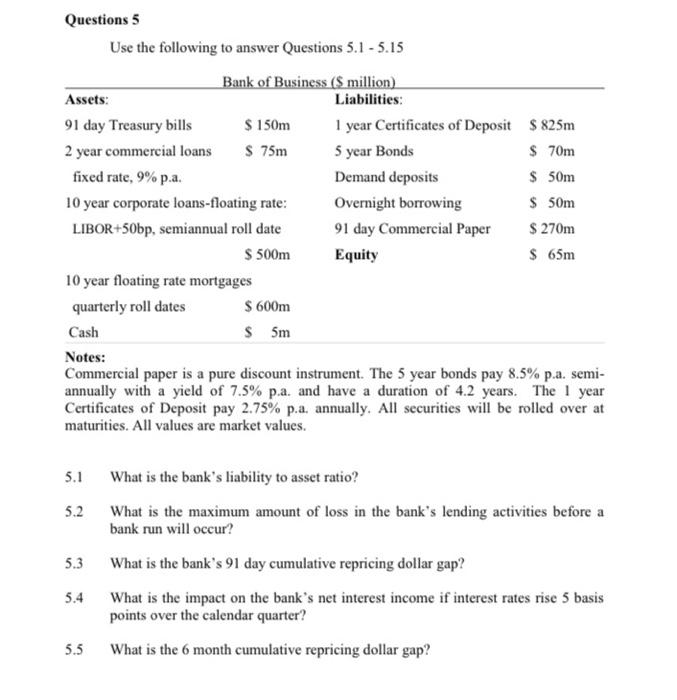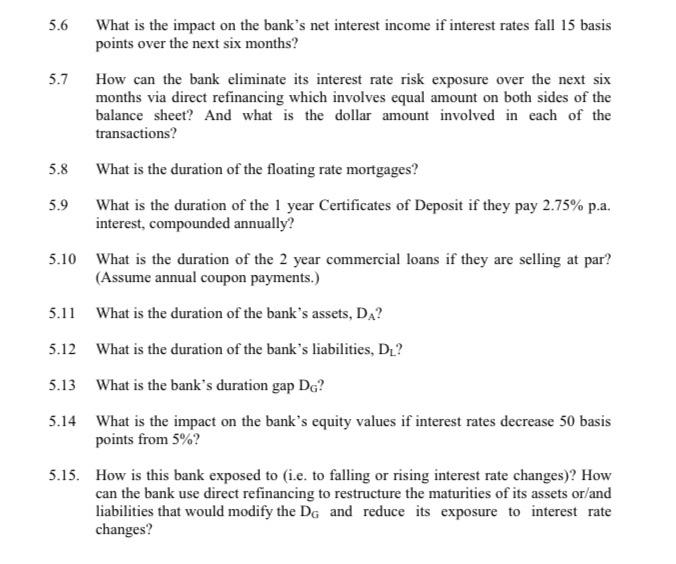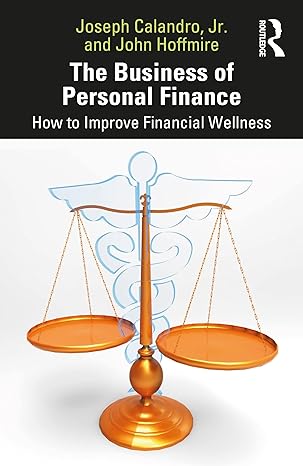Questions 5 Use the following to answer Questions 5.1 - 5.15 Bank of Business ($ million) Assets: Liabilities: 91 day Treasury bills $ 150m 1 year Certificates of Deposit $825m 2 year commercial loans $ 75m 5 year Bonds $ 70m fixed rate, 9% p.a. Demand deposits $ 50m 10 year corporate loans-floating rate: Overnight borrowing $ 50m LIBOR+50bp, semiannual roll date 91 day Commercial Paper $ 270m $ 500m Equity $ 65m 10 year floating rate mortgages quarterly roll dates $ 600m Cash $ 5m Notes: Commercial paper is a pure discount instrument. The 5 year bonds pay 8.5% p.a. semi- annually with a yield of 7.5% p.a. and have a duration of 4.2 years. The 1 year Certificates of Deposit pay 2.75% p.a. annually. All securities will be rolled over at maturities. All values are market values. 5.1 5.2 5.3 What is the bank's liability to asset ratio? What is the maximum amount of loss in the bank's lending activities before a bank run will occur? What is the bank's 91 day cumulative repricing dollar gap? What is the impact on the bank's net interest income if interest rates rise 5 basis points over the calendar quarter? What is the 6 month cumulative repricing dollar gap? 5.4 5.5 5.6 5.7 What is the impact on the bank's net interest income if interest rates fall 15 basis points over the next six months? How can the bank eliminate its interest rate risk exposure over the next six months via direct refinancing which involves equal amount on both sides of the balance sheet? And what is the dollar amount involved in each of the transactions? 5.8 What is the duration of the floating rate mortgages? 5.9 What is the duration of the 1 year Certificates of Deposit if they pay 2.75% p.a. interest, compounded annually? 5.10 What is the duration of the 2 year commercial loans if they are selling at par? (Assume annual coupon payments.) 5.11 What is the duration of the bank's assets, DA? 5.12 What is the duration of the bank's liabilities, D_? 5.13 What is the bank's duration gap DG? 5.14 What is the impact on the bank's equity values if interest rates decrease 50 basis points from 5%? 5.15. How is this bank exposed to (i.e. to falling or rising interest rate changes)? How can the bank use direct refinancing to restructure the maturities of its assets or/and liabilities that would modify the Dg and reduce its exposure to interest rate changes? Questions 5 Use the following to answer Questions 5.1 - 5.15 Bank of Business ($ million) Assets: Liabilities: 91 day Treasury bills $ 150m 1 year Certificates of Deposit $825m 2 year commercial loans $ 75m 5 year Bonds $ 70m fixed rate, 9% p.a. Demand deposits $ 50m 10 year corporate loans-floating rate: Overnight borrowing $ 50m LIBOR+50bp, semiannual roll date 91 day Commercial Paper $ 270m $ 500m Equity $ 65m 10 year floating rate mortgages quarterly roll dates $ 600m Cash $ 5m Notes: Commercial paper is a pure discount instrument. The 5 year bonds pay 8.5% p.a. semi- annually with a yield of 7.5% p.a. and have a duration of 4.2 years. The 1 year Certificates of Deposit pay 2.75% p.a. annually. All securities will be rolled over at maturities. All values are market values. 5.1 5.2 5.3 What is the bank's liability to asset ratio? What is the maximum amount of loss in the bank's lending activities before a bank run will occur? What is the bank's 91 day cumulative repricing dollar gap? What is the impact on the bank's net interest income if interest rates rise 5 basis points over the calendar quarter? What is the 6 month cumulative repricing dollar gap? 5.4 5.5 5.6 5.7 What is the impact on the bank's net interest income if interest rates fall 15 basis points over the next six months? How can the bank eliminate its interest rate risk exposure over the next six months via direct refinancing which involves equal amount on both sides of the balance sheet? And what is the dollar amount involved in each of the transactions? 5.8 What is the duration of the floating rate mortgages? 5.9 What is the duration of the 1 year Certificates of Deposit if they pay 2.75% p.a. interest, compounded annually? 5.10 What is the duration of the 2 year commercial loans if they are selling at par? (Assume annual coupon payments.) 5.11 What is the duration of the bank's assets, DA? 5.12 What is the duration of the bank's liabilities, D_? 5.13 What is the bank's duration gap DG? 5.14 What is the impact on the bank's equity values if interest rates decrease 50 basis points from 5%? 5.15. How is this bank exposed to (i.e. to falling or rising interest rate changes)? How can the bank use direct refinancing to restructure the maturities of its assets or/and liabilities that would modify the Dg and reduce its exposure to interest rate changes








